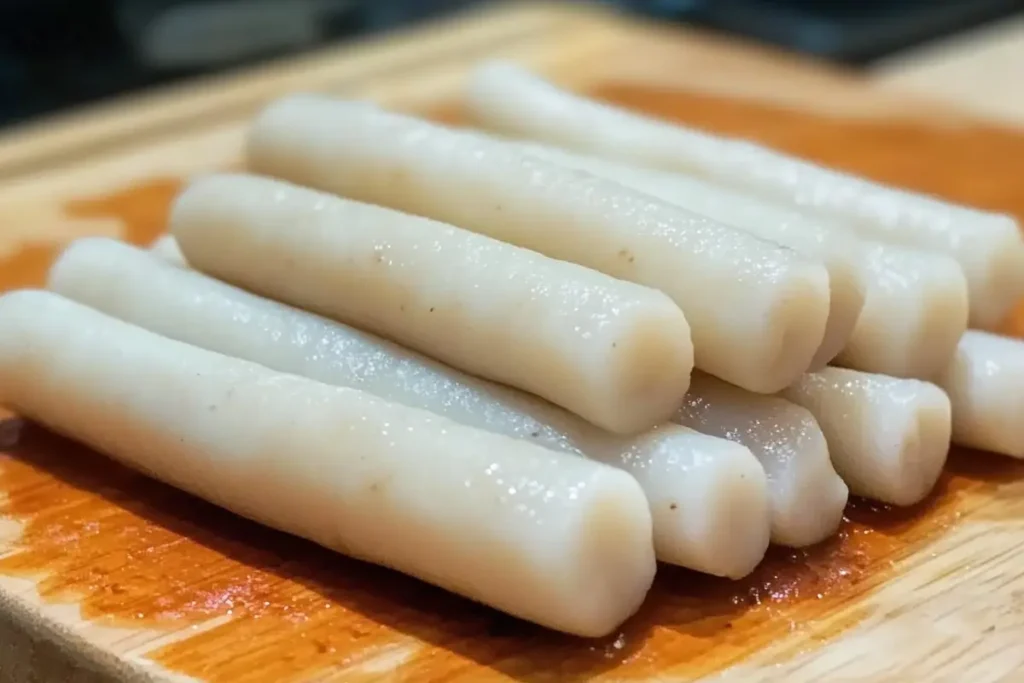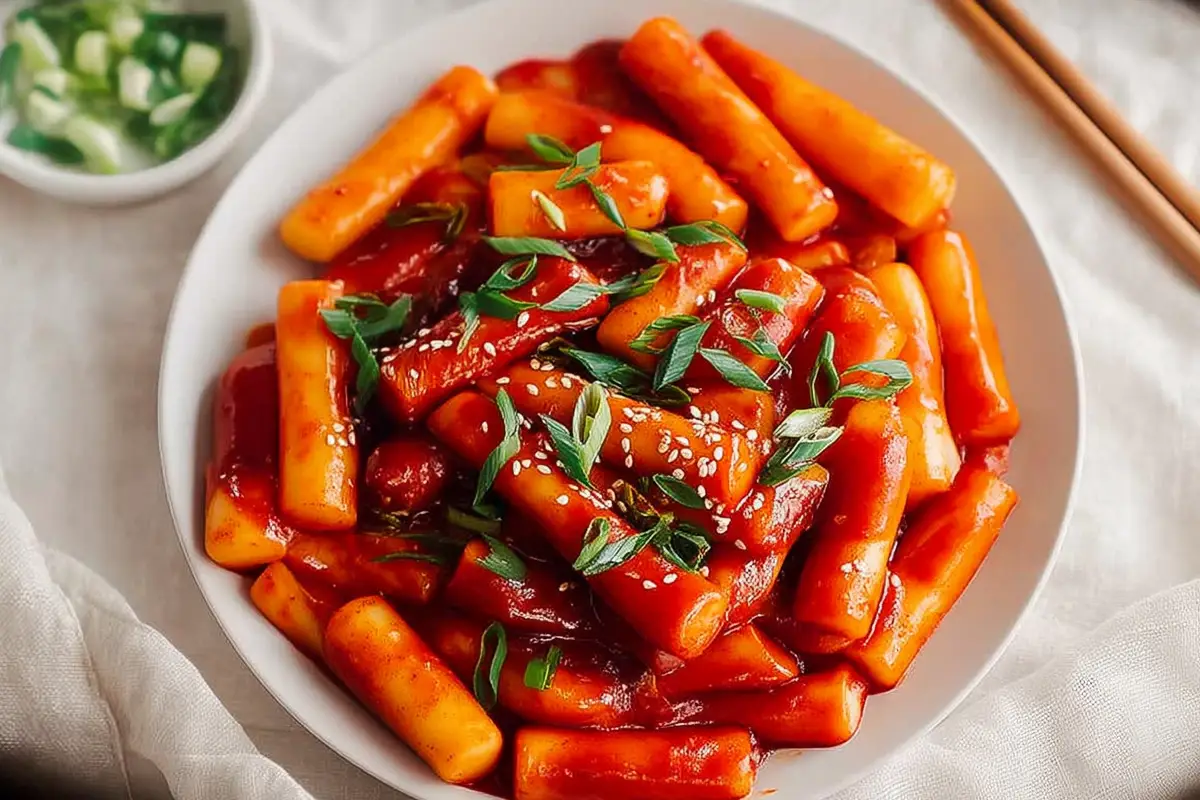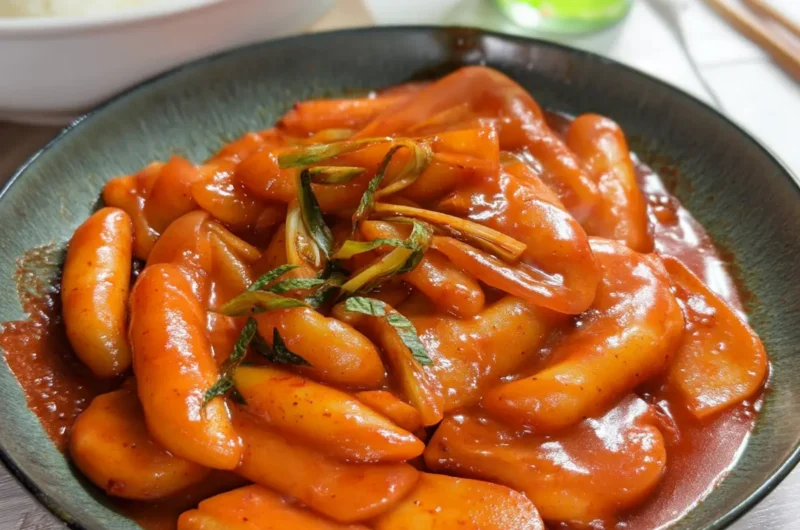Last Updated on May 9, 2025 by Souhail
There’s something about tteokbokki (떡볶이) that makes it completely irresistible, chewy rice cakes swimming in a fiery, sweet-and-spicy gochujang sauce that clings to every bite. This beloved Korean street food isn’t just a snack, it’s a full-on flavor experience that’s bold, comforting, and endlessly satisfying.
Whether you’re already a K-food fan or just dipping your toes into Korean cooking, tteokbokki is the perfect place to start. It’s simple to make at home, and easy to customize with fish cakes, scallions, boiled eggs, or even melty cheese. This recipe walks you through the essentials while leaving room for your own twist. Ready to bring a taste of Seoul to your kitchen? Let’s make some tteokbokki!
Table of contents
Why This Recipe Works
Tteokbokki isn’t just rice cakes in sauce, it’s all about getting the texture and flavor just right. Here’s why this recipe stands out:
- Perfectly Chewy Rice Cakes
Soft, chewy tteok are the heart of the dish. Whether you’re using fresh or frozen, this recipe shows you how to cook them to perfection. - Just-Right Sauce
Spicy, sweet, and savory, this sauce hits all the right notes with gochujang, gochugaru, soy sauce, and sugar. No overpowering heat or sweetness here, just balanced flavor. - Make It Yours
Add fish cakes, eggs, scallions, or even cheese. Want it spicier? Vegetarian? You’ll find easy ways to tweak it. - Simple, Step-by-Step
Even if you’re new to Korean cooking, you’ll have no problem following along. - Diet-Friendly Options
Need it gluten-free or meat-free? There are tips for that too.
Ready to get cooking? Let’s dive into the ingredients and steps!
Ingredients Breakdown for Tteokbokki Recipe
To make Tteokbokki, you’ll need a mix of pantry staples and a few key Korean ingredients. Here’s what you’ll need, with a breakdown of their purpose:
Main Ingredients

- Rice Cakes (Tteok) – 500g
- These cylindrical rice cakes are the heart of tteokbokki. You can find them fresh, refrigerated, or frozen in Asian grocery stores. If frozen, soak them in warm water for 20-30 minutes before cooking.
- Fish Cakes (Eomuk) – 200g
- Adds a savory, umami depth to the dish. Look for flat sheets of fish cake, which can be sliced into rectangles or triangles.
- Boiled Eggs – 2
- Optional but classic, boiled eggs absorb the sauce beautifully and add richness.
- Scallions – 2 stalks
- For garnish and a touch of freshness.
For the Sauce
- Water or Anchovy Stock – 2 cups
- Anchovy stock enhances the flavor, but plain water works fine. To make the stock, simmer a handful of dried anchovies and kelp in water for 10 minutes.
- Gochujang (Korean Chili Paste) – 2 tablespoons
- The main source of heat and depth, with a slight sweetness.
- Gochugaru (Korean Chili Flakes) – 1 tablespoon
- Adds extra heat and a bright red color. Adjust to taste.
- Soy Sauce – 1 tablespoon
- For a salty, umami layer to balance the sweetness.
- Sugar – 1 tablespoon
- Balances the spiciness with a hint of sweetness.
- Garlic – 3 cloves, minced
- Adds aromatic depth.
Optional Toppings
- Mozzarella Cheese – 1 cup, shredded
- For a fusion twist, melt cheese over the dish for a gooey, indulgent finish.
- Sesame Seeds – 1 teaspoon
- A nutty garnish to sprinkle before serving.
You can easily find authentic Asian food ingredients, including gochujang and rice cakes, at online stores like Weee! for convenience and variety.
Step-by-Step Instructions
1. Prepare the Ingredients (10 minutes)
- If using frozen rice cakes, soak them in warm water for 20 minutes to soften. For fresh or refrigerated rice cakes, a quick rinse under cool water suffices.
- Slice the fish cakes into bite-sized pieces, and chop scallions into 2-inch segments. Boil and peel the eggs if you’re including them.
2. Make the Base Stock (10 minutes)
- In a medium pot, bring 2 cups of water or anchovy stock to a boil. The anchovy stock gives the dish a rich foundation but isn’t essential.
3. Mix the Sauce (5 minutes)
- While the stock heats, combine gochujang, gochugaru, soy sauce, and sugar in a small bowl. Stir until smooth.
4. Cook the Sauce and Tteok (15 minutes)
- Add the sauce mixture and minced garlic to the boiling stock. Stir well to dissolve the paste.
- Reduce the heat to medium and add the rice cakes. Simmer for 10-15 minutes, stirring occasionally to prevent sticking. The sauce will thicken as the rice cakes cook and release starch.
5. Add the Fish Cakes and Eggs (5 minutes)
- Toss in the fish cakes and boiled eggs. Let them simmer in the sauce for about 5 minutes, allowing the flavors to meld.
6. Finish and Garnish (5 minutes)
- Once the sauce reaches your desired consistency (thick but pourable), turn off the heat. Add scallions and, if desired, shredded mozzarella. Let the cheese melt slightly before serving.
- Garnish with sesame seeds for a final touch.
Serving Time!
Transfer the tteokbokki to a large serving dish or individual bowls. Serve immediately while hot and enjoy its chewy, spicy goodness.
Pro Tips for Success
- Achieving the Perfect Sauce Consistency
- If the sauce becomes too thick, add small amounts of water or stock to loosen it. Conversely, if it’s too thin, let it simmer a bit longer without a lid.
- Don’t Overcook the Rice Cakes
- Overcooking can make rice cakes mushy. Once they’re soft and chewy, remove the pot from heat to preserve their texture.
- Adjusting the Spice Level
- For a milder version, reduce the amount of gochugaru or use a sweeter gochujang. For more heat, add extra chili flakes or a dash of hot sauce.
- Making Vegetarian Tteokbokki Recipe
- Skip the fish cakes and anchovy stock, using water or vegetable stock instead. You can also add mushrooms, tofu, or extra veggies for a heartier dish.
- Cheese Tip
- If adding cheese, let it melt fully before serving for an even, gooey texture. Using a kitchen torch can create a charred, smoky effect for added flavor.
- Stock-Free Shortcut
- When short on time, water works just fine as the base, especially if your gochujang is high-quality and flavorful.
- Storage Tip
- Leftover tteokbokki tends to thicken as it cools. Reheat with a splash of water to restore the sauce’s original consistency.
Variants of the Tteokbokki Recipe
One of the best things about tteokbokki is how versatile it is. Here are some delicious variations to suit different tastes and occasions:
1. Cheese Tteokbokki
- Add a generous topping of shredded mozzarella cheese over the cooked tteokbokki. Cover the pot for a minute or two, or use a broiler to melt the cheese until bubbly. This version is creamy, indulgent, and perfect for those who enjoy a fusion twist.
2. Rabokki (Ramen Tteokbokki)
- Combine the rice cakes with instant ramen noodles for a heartier meal. Add the noodles in the last 5-7 minutes of cooking, ensuring they absorb the sauce while maintaining a slightly chewy texture.
3. Seafood Tteokbokki
- Include fresh seafood such as shrimp, squid, or mussels. Add them halfway through cooking for a briny, umami flavor that complements the spicy sauce beautifully.
4. Vegetable Tteokbokki
- A vegetarian-friendly version that swaps fish cakes for hearty vegetables like broccoli, carrots, zucchini, or mushrooms. A great option for veggie lovers or those seeking a lighter dish.
5. Creamy Tteokbokki
- Soften the spice by adding a splash of heavy cream or coconut milk to the sauce. This version creates a velvety, mildly spicy dish that’s comforting and unique.
6. Jajang Tteokbokki
- Combine tteokbokki with jajang sauce, made from black bean paste. This savory, slightly sweet variation is less spicy and has a deep, earthy flavor.
7. Street-Style Tteokbokki Recipe
- Emulate the simplicity of Korean street food by focusing on just the rice cakes, fish cakes, and sauce. Serve in a paper cup with toothpicks for an authentic experience.
Serving Suggestions
The beauty of tteokbokki lies in its adaptability. Whether served as a main dish, side, or snack, here are some ways to elevate the experience:
1. Classic Pairings
- Pair with kimchi for a tangy, fermented contrast to the spicy-sweet sauce.
- Serve alongside kimbap (Korean rice rolls) for a well-rounded meal. The clean flavors of kimbap balance the boldness of tteokbokki.
- Add a side of Korean fried chicken for the ultimate comfort-food combo.
2. Fusion Add-Ons
- Top with fried eggs or crispy bacon bits for a breakfast-inspired version.
- Pair with garlic bread or naan to soak up the sauce.
3. Drink Pairings
- Enjoy with a cold glass of Korean soju, a fruity makgeolli (rice wine), or even a refreshing soda. The slightly sweet and tangy drinks offset the spiciness.
4. Garnishing Ideas
- Sprinkle with crushed peanuts or fried onions for added texture.
- Add a drizzle of honey or sesame oil for a touch of sweetness and depth.
5. Family-Style Sharing
- Serve in a hot pot or skillet at the center of the table, surrounded by small bowls of side dishes like pickled radish or seasoned spinach.
Recipe Card
FAQs
Tteokbokki primarily consists of rice cakes (tteok) simmered in a spicy-sweet sauce made with gochujang (Korean chili paste). It often includes fish cakes, boiled eggs, and scallions.
Yes! Reduce or omit the gochugaru and choose a mild gochujang. Adding a splash of cream or milk can also mellow the heat.
Korean rice cakes are unique in texture, but you can substitute with thick rice noodles or even gnocchi for a similar chewy experience.
Rice cakes are naturally gluten-free, but some gochujang and soy sauces contain gluten. Look for certified gluten-free brands to adapt this recipe.
Rice cakes can harden when stored or frozen. Soak them in warm water before cooking to restore their chewiness.
While it’s best fresh, you can prepare the sauce and rice cakes separately ahead of time. Reheat together with a splash of water to restore the sauce consistency.
Story or Cultural Context of Tteokbokki Recipe
Tteokbokki’s roots trace back to the Joseon Dynasty, where it was a royal dish known as gungjung tteokbokki, made with soy sauce instead of chili paste. The modern spicy version became popular in the mid-20th century, thanks to the introduction of gochujang and its widespread availability. Today, tteokbokki is a beloved comfort food, celebrated for its street-food charm and ability to bring people together over a shared pot of deliciousness.
Health Benefits of Tteokbokki
While tteokbokki is known for its bold flavors, it also has nutritional perks when balanced properly:
- Energy Boost: The rice cakes provide a quick source of carbohydrates, making it a great pre-workout or energy-boosting meal.
- Rich in Protein: Adding fish cakes, eggs, or seafood increases protein content, supporting muscle repair and growth.
- Capsaicin Benefits: The spice from gochujang and gochugaru may help boost metabolism and improve circulation.
- Antioxidants: Garlic, chili paste, and scallions are rich in antioxidants, which can support immune health.
For a healthier version, you can use less sugar, incorporate more vegetables, and skip the cheese to reduce calories.
Final Thoughts
Cooking tteokbokki at home brings the vibrant spirit of Korean street food to your kitchen. With its spicy-sweet sauce and chewy rice cakes, this dish is an absolute crowd-pleaser. Whether you keep it traditional or add your personal twist, tteokbokki is endlessly customizable and perfect for any occasion.
If you’ve enjoyed this recipe, why not explore other Asian favorites like Chopped Almonds with Asian Sauce Recipe or Din Tai Fung Cucumber Recipe? Don’t forget to share your tteokbokki creations, we’d love to hear how you made it your own!
So, why not gather your ingredients, roll up your sleeves, and dive into the wonderful world of tteokbokki? The bold, spicy-sweet sauce, the satisfying chew of rice cakes, and the joy of creating something so delicious will keep you coming back for more. Give it a try, and don’t forget to share your experience, we’d love to hear from you!


